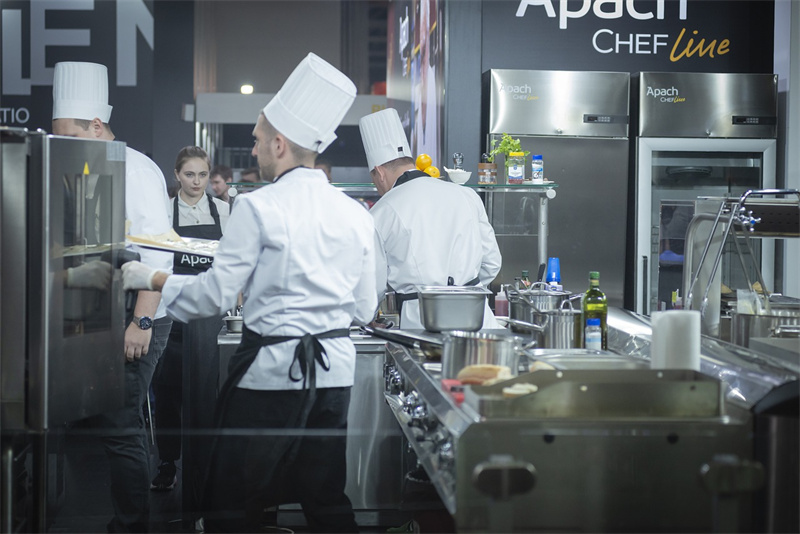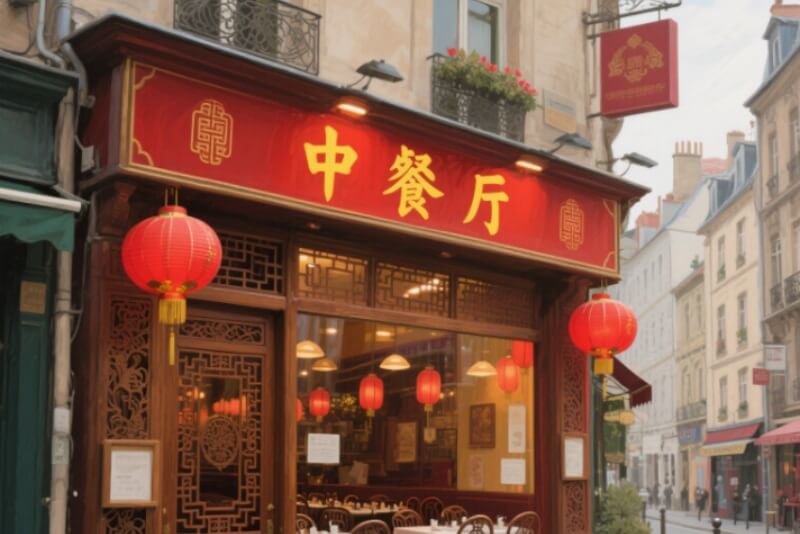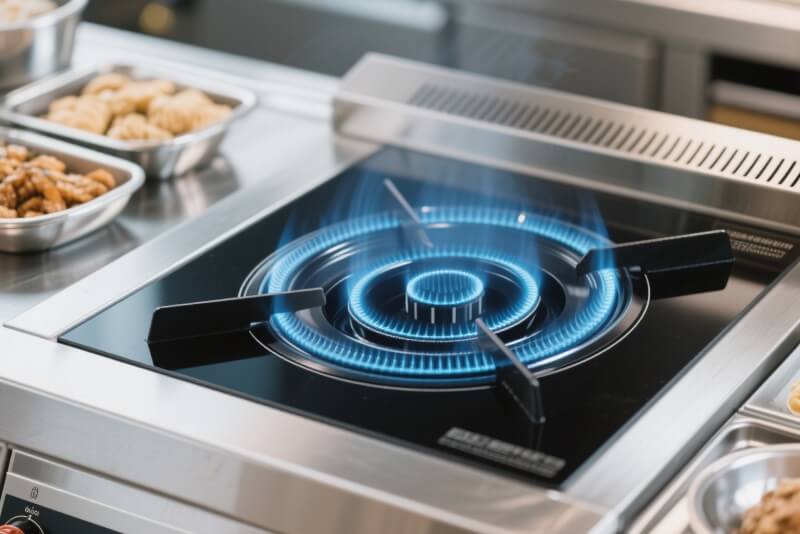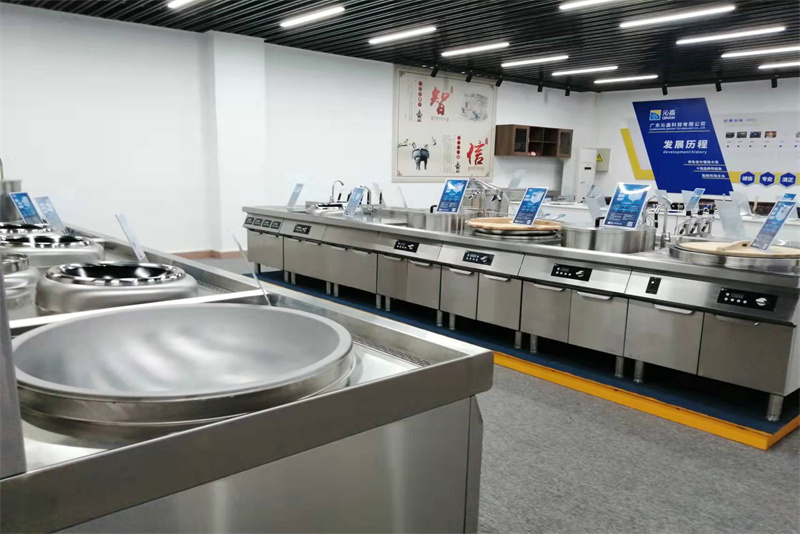Opening a Chinese restaurant in Europe presents many opportunities and challenges. To run the restaurant…

A Complete Guide to Purchasing Commercial Cooking Equipment for Opening a Restaurant – for Owner II
As a restaurant owner, the selection of kitchen equipment is one of the keys to the success of the restaurant operation. Appropriate commercial cooking equipment can not only improve cooking efficiency but also ensure food safety and quality. The following is a detailed guide on the selection of commercial cooking equipment.
IV. Supplier Selection and After-sales Service: Ensuring Long-term Stable Operation
The professionalism of the supplier is a key factor to be evaluated when purchasing commercial kitchen equipment. During the preparation of the restaurant, I heard that my peers had to renovate and renovate because they chose unprofessional suppliers, which caused the kitchen design and water and electricity layout to be completely mismatched. It not only wasted tens of thousands of yuan in funds but also delayed the opening time.
This lesson made me deeply realize the importance of choosing a reliable supplier. A high-quality supplier should not only provide equipment but also have kitchen process knowledge, equipment installation experience, and kitchen water and electricity design capabilities. When screening suppliers, I will conduct on-site inspections of their factory scale and professional qualifications to ensure that the other party is capable of providing a full range of solutions, not just equipment sales.
1. Reliable Suppliers
Peer recommendations are an effective way to find reliable suppliers. After determining my equipment needs, I consulted with several colleagues in the catering industry to learn about the suppliers they cooperated with and their experience. This word-of-mouth survey helped me initially screen out a group of potential suppliers.
Then, I invited these suppliers to provide solutions and quotations and judged their professionalism and integrity by comparing their statements and suggestions. In this process, I found that the solutions provided by professional suppliers are often more comprehensive and detailed, taking into account the rationality of the kitchen workflow between equipment rather than simply piling up equipment lists.
2. Price and Service Matching
Price and service matching is another key indicator for evaluating suppliers. In business decisions, price should never be the only consideration. Through market research, the price range of commercial kitchen equipment is very large, but mid-priced products usually represent the best value balance. The price will not be too high to cause budget constraints nor too low to sacrifice quality and service.
Extremely low-priced products often have a big discount on quality or after-sales service, and suppliers who ask for sky-high prices may lack sincerity. My strategy is “physical store inspection plus three quotations” by checking the quality and function of the equipment on the spot and obtaining quotations from multiple suppliers at the same time so as to make the most cost-effective choice.
3. Brand Awareness and Reputation
Brand awareness and reputation are also important references for supplier evaluation. Well-known brands usually have stricter quality control systems and more complete after-sales service networks. During the purchase process, I will learn about the reputation and user reviews of each brand through channels such as Internet searches and catering industry forums.
It is worth noting that different brands may have their strengths in different equipment categories, so I adopted the strategy of “classification optimization” – choose brand A for stoves and brand B for refrigeration equipment, rather than unthinkingly pursuing a full set of solutions from a single brand.
4. After-sales Service
The degree of perfection of the after-sales service network is directly related to the maintenance guarantee of the equipment in the later stage. Before signing the contract, I will learn about the supplier’s after-sales service policy in detail, including the warranty period, warranty scope, response time, etc.
High-quality suppliers usually have service outlets across the country and can respond quickly after receiving repair reports and dispatch technicians to repair on-site promptly.
For my restaurant, the ability to quickly repair equipment when it fails is crucial, and any long-term downtime may lead to business losses and customer loss. Therefore, I particularly value the supplier’s local service coverage and response speed.
5. Warranty Terms
Warranty terms need to be carefully reviewed. Generally speaking, the warranty period of commercial kitchenware should be around 1-3 years. During the warranty period, faults caused by non-human factors should be repaired or replaced free of charge. I will pay special attention to the exclusions in the warranty terms to avoid subsequent disputes due to misunderstandings.
In addition, some high-end brands also provide regular maintenance services. This preventive maintenance can significantly extend the service life of the equipment and reduce the probability of sudden failures.
6. Parts Supply
Parts supply is another long-term factor to consider. After several years of use, some wearing parts of commercial kitchenware may need to be replaced. I will ask the supplier about the inventory and supply cycle of commonly used parts to ensure that timely maintenance services can be obtained even if the equipment is out of warranty.
In this regard, well-known brands usually have more advantages because their product lines are stable, and the supply of parts is guaranteed. However, some small manufacturers or OEM products may have the risk of discontinuation of parts, resulting in premature scrapping of equipment.
7. User Training
User training is also an important part of after-sales service. Commercial kitchen equipment is usually more complex than household equipment. Improper operation not only affects the intended use but also may cause safety hazards. Good suppliers will provide operation training services to guide kitchen staff to use and maintain equipment correctly.
Before my restaurant opened, I required all suppliers to arrange special operation training to ensure that every relevant employee could master the use of the equipment. This initial investment greatly reduced subsequent operation errors and equipment damage.
8. Technical Support
The continued availability of technical support is equally important. In daily operations, it is inevitable to encounter various equipment usage problems or minor faults. Good suppliers will provide technical consultation hotlines or online support to help quickly solve simple problems and avoid unnecessary door-to-door services. I set up an emergency address book with the contact information of each supplier to ensure that professional support can be obtained quickly at any time.
Summary
Through a comprehensive evaluation of suppliers and a strict review of after-sales service terms, I was able to choose truly reliable partners to provide guarantees for the long-term and stable operation of the restaurant. This seemingly cumbersome preliminary work actually avoids many potential problems and additional costs for subsequent operations and is an important investment in the successful operation of the restaurant.
-
 Portable Dual Basket Restaurant Induction Deep Fryer LT-TZL-B105
Portable Dual Basket Restaurant Induction Deep Fryer LT-TZL-B105 -
 Tabletop 2 Burners Restaurant Induction Wok Cooker LT-TPA-B135
Tabletop 2 Burners Restaurant Induction Wok Cooker LT-TPA-B135 -
 Tabletop 2 Burners Restaurant Induction Stovetop LT-TPP-B135
Tabletop 2 Burners Restaurant Induction Stovetop LT-TPP-B135 -
 Full Glass Commercial Drop-in Induction Cooktop LT-QPM-C335
Full Glass Commercial Drop-in Induction Cooktop LT-QPM-C335 -
 Tabletop Commercial Induction Cooktops 6 Burner LT-TBZ300VI-B135
Tabletop Commercial Induction Cooktops 6 Burner LT-TBZ300VI-B135 -
 5000W Countertop Restaurant Induction Wok Ranges LT-TAM-B505
5000W Countertop Restaurant Induction Wok Ranges LT-TAM-B505 -
 Restaurant Tabletop Induction Cooktop 3500W LT-TPM-B535
Restaurant Tabletop Induction Cooktop 3500W LT-TPM-B535 -
 3500W Commercial Countertop Induction Cooker LT-TPM-B135
3500W Commercial Countertop Induction Cooker LT-TPM-B135 -
 Tabletop 4 Burner Commercial Induction Hob 3500W LT-TBZ300IV-B135
Tabletop 4 Burner Commercial Induction Hob 3500W LT-TBZ300IV-B135
V. Practical Purchasing Strategies and Precautions: From Theory to Practice
A phase-based purchasing strategy is an effective way to control initial investment risks. In the process of opening a restaurant, I realized that not all equipment needs to be purchased at once before opening. According to actual operational needs, I divided equipment procurement into two stages: essential equipment and expansion equipment.
Necessary equipment includes stoves, refrigeration equipment, basic processing equipment, and other core equipment that directly affect the opening of the restaurant, while expansion equipment such as additional steamers and special pastry machines can be gradually added according to actual needs after the business stabilizes. This strategy not only reduces the initial capital pressure but also avoids the waste of equipment idleness caused by blind procurement.
1. Field Investigation
Field investigation is a key step to avoid purchasing mistakes. Before making a final decision, I insisted on going to the supplier’s showroom or existing customer restaurants to check the operation of the equipment. This experience of seeing it with my own eyes is far more convincing than product manuals and sales pitches.
During the inspection, I will pay special attention to parameters such as the equipment’s working noise, ease of operation, and actual production capacity, which are difficult to reflect in paper data accurately. During one inspection, I found that although certain equipment had excellent technical parameters, the operation interface design was complicated and not suitable for the technical level of my restaurant staff, so I decisively gave up the option.
2. Overall Coordination
Overall coordination is an important principle of modern commercial kitchen design. Today’s kitchens are increasingly focusing on streamlined operations, and equipment needs to work seamlessly to avoid crossover and conflict. When purchasing equipment, I will consider equipment of the same brand or series because their operating logic, control panel design are usually consistent, which can reduce the learning cost and confusion of employees.
For example, the valve design, digital display screen, etc., of the same brand of frying stoves and soup stoves often use similar operating methods, which greatly improves work efficiency and safety.
3. Aesthetics
Aesthetic considerations have become particularly important in open kitchen design. With the popularity of the concept of transparent kitchens, more and more customers will watch the kitchen operation process through windows or glass. Kitchen equipment with a unified style not only gives people a professional and neat impression but also facilitates daily cleaning and maintenance.
In my restaurant design, I chose a series of equipment with unified tones and simple lines to make the kitchen look orderly. This visual presentation invisibly enhances customers’ trust in the hygiene and professionalism of the restaurant.
-
 Tabletop Automatic Wok Cooking Machine for Restaurant Kitchen LT-CD300T-C205
Tabletop Automatic Wok Cooking Machine for Restaurant Kitchen LT-CD300T-C205 -
 Tabletop Automatic Stir-frying Wok Machine for Restaurant LT-CD300T-C105
Tabletop Automatic Stir-frying Wok Machine for Restaurant LT-CD300T-C105 -
 Industrial Automatic Wok Cooking Machine Stir-Fryer LT-CD700T4-D130
Industrial Automatic Wok Cooking Machine Stir-Fryer LT-CD700T4-D130 -
 Automatic Robotic Wok Cooking Machine for Restaurant Canteen LT-CD300L-A205
Automatic Robotic Wok Cooking Machine for Restaurant Canteen LT-CD300L-A205 -
 Countertop Commercial Gas Automatic Fried Rice Machine LT-TGD36R
Countertop Commercial Gas Automatic Fried Rice Machine LT-TGD36R -
 Automatic Cooking 6 Burners Commercial Induction Cooker LT-B300VI-E235
Automatic Cooking 6 Burners Commercial Induction Cooker LT-B300VI-E235 -
 LT-CJ550-D208 Ming Stall Commercial Automatic Stir-fry Wok Machine
LT-CJ550-D208 Ming Stall Commercial Automatic Stir-fry Wok Machine -
 Industrial Electric Automatic Stirring Stew Wok LT-XC80
Industrial Electric Automatic Stirring Stew Wok LT-XC80 -
 Heavy-duty Automatic Stir-Fryer Cooking Robot LT-GD36/9
Heavy-duty Automatic Stir-Fryer Cooking Robot LT-GD36/9
4. Flexible Mobility
Flexibility and mobility are practical features for restaurants to adapt to changes in development. Commercial kitchen equipment is often thought to be fixed once installed, but business adjustments, menu changes, or space optimization may require the re-layout of equipment.
Therefore, I would give priority to large equipment designed with mobile wheels or easy to disassemble and assemble, such as fresh-keeping refrigerators, warming cabinets, etc. This design shows great advantages when hosting large banquets or temporarily adjusting the kitchen layout, and the equipment can be pushed to any desired location.
5. Easy to Clean
Easy-to-clean design directly affects the daily operating efficiency and hygiene standards of the kitchen. When purchasing equipment, I will pay special attention to products that are easy to disassemble, have smooth surfaces, and have good corrosion resistance. Complex cleaning work is not only time-consuming and labor-intensive but may also pose health risks due to incomplete cleaning.
Choosing equipment with no dead corners, smooth corners, and many removable parts will make daily cleaning and maintenance easier and more thorough. Some high-end equipment is even designed with automatic cleaning programs, which further simplifies maintenance.
6. Versatility
Versatility is ideal for kitchens with limited space. A device with multiple functions can reduce investment costs, save kitchen space, and reduce manpower requirements. In my kitchen, I chose several multifunctional cooking devices, such as a combination stove that can fry, boil, and steam at the same time and a multifunctional cooking center that integrates oven, steamer, and microwave functions. This integrated design not only improves space utilization but also increases the flexibility of the menu design.
7. Employee Adaptability
Employee adaptability is an easily overlooked but crucial factor in equipment selection. The catering industry has a large turnover of employees and uneven cultural levels. An overly complex operating interface will increase the difficulty of training and usage errors.
Therefore, I will give priority to those devices that are intuitive to operate and have clear functions so that users can “know at a glance and learn at a glance.” In actual testing, I will invite chefs who will operate these devices in the future to participate in the evaluation because their experience and feedback are often the most valuable for reference.
8. Future Scalability
Future scalability is a factor that needs to be considered for long-term operations. As the business develops, restaurants may need to increase equipment capacity or add new functions. In the initial purchase, I will choose products with modular designs to facilitate subsequent functional expansion or capacity improvement.
For example, some stove systems allow additional burners to be added later without replacing the entire system; some refrigeration equipment can also be stacked or connected in parallel to respond to changes in storage needs.
9. Payment and Delivery
Payment and delivery terms need to be carefully negotiated. Commercial kitchen equipment usually costs a large amount. I will strive for installment payment and keep part of the payment until the equipment is installed and debugged, and I am satisfied. At the same time, clarify details such as delivery time, installation responsibility, and acceptance criteria to avoid disputes due to misunderstandings.
In the contract terms, I will pay special attention to the penalty clauses for delayed delivery and the handling method for non-conformity of quality to protect my legal rights and interests.
Conclusion
Through the above practical purchasing strategies and precautions, I can more rationally and comprehensively evaluate various types of commercial cooking equipment and make purchasing decisions that best meet the actual needs of the restaurant. These experiences not only helped me establish an efficient and economical kitchen system in the early stage but also reserved sufficient flexibility for the subsequent operation adjustment and development of the restaurant.
automatic cooking machine automatic cooking machines bbq chip fryer commercial cooking equipment commercial drop in induction cooker commercial food steamer commercial induction cooker commercial induction cooktop commercial induction deep fryer commercial induction fryer commercial induction hob commercial induction soup cooker Commercial Induction Steamer Cooker commercial induction wok cooker commercial kitchen cookware food steamer hob induction cooker induction cookware INDUCTION FRYER induction grill induction hob iron wok kitchen equipment repair guide restaurangt equipment restaurant equipment stainless steel cookware user's guidance



This Post Has 0 Comments